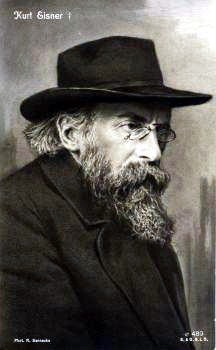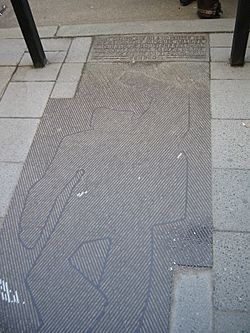Kurt Eisner facts for kids
Quick facts for kids
Kurt Eisner
|
|
|---|---|
 |
|
| Minister President of the People's State of Bavaria | |
| In office 8 November 1918 – 21 February 1919 |
|
| Preceded by | Otto Ritter von Dandl (as Chairman of the Council of Ministers) |
| Succeeded by | Johannes Hoffmann |
| Personal details | |
| Born | 14 May 1867 Berlin, Brandenburg, Prussia |
| Died | 21 February 1919 (aged 51) Munich, Bavaria, Germany |
| Nationality | German |
| Political party | Independent Social Democratic Party of Germany (1917–1919) Social Democratic Party of Germany (1898–1917) |
Kurt Eisner (14 May 1867 – 21 February 1919) was an important German politician, a revolutionary, a journalist, and a theatre critic. He was a socialist journalist who helped start a revolution in November 1918. This revolution removed the old royal family, the Wittelsbachs, from power in Bavaria. Because of his role, he became known as "the symbol of the Bavarian revolution."
Eisner then announced the creation of the People's State of Bavaria. Sadly, he was killed by a far-right German nationalist named Anton Graf von Arco auf Valley in Munich on 21 February 1919.
Contents
Kurt Eisner's Life and Work
Growing Up and Becoming a Journalist
Kurt Eisner was born in Berlin on 14 May 1867. His parents, Emanuel Eisner and Hedwig Levenstein, were both Jewish. He was married to Elisabeth Hendrich from 1892 to 1917 and they had five children. After they divorced, Eisner married Elise Belli, who was an editor. They had two daughters together.
Eisner first studied philosophy, but then he became a journalist. From 1890 to 1895, he worked for the Frankfurter Zeitung newspaper. During this time, he wrote an article that criticized Kaiser Wilhelm II, who was the German emperor. For this, he was sent to prison for nine months.
Eisner always believed in a republic, where the people choose their leaders, instead of a king. He also joined the SPD in 1898. He became the editor of Vorwärts in 1900. Later, he worked as a freelance journalist in Munich.
Leading the Bavarian Revolution
In 1917, during World War I, Eisner joined a new political group called the Independent Social Democratic Party of Germany. He was accused of working against the government in 1918 because he helped organize a strike of workers who made weapons. He spent nine months in prison but was released in October of that year.
After leaving prison, Eisner led the revolution that ended the rule of the king in Bavaria. On 8 November 1918, he declared Bavaria a free state and a republic, calling it the People's State of Bavaria. He became Bavaria's first leader under this new system.
Eisner believed that Germany was responsible for starting World War I. At a meeting of socialists in Switzerland, he spoke out against other German socialists who didn't want to admit Germany's part in the war. Many people in Germany disliked him for this speech and for his strong views against Prussia.
His Tragic Death and Lasting Memory
Kurt Eisner was killed in Munich on 21 February 1919. He was shot in the back by a German nationalist named Anton Graf von Arco auf Valley. Eisner was on his way to resign from his position to the Bavarian parliament when he was attacked.
His death caused a lot of trouble. The elected government of Bavaria had to leave Munich. This led to the creation of a short-lived government called the Bavarian Soviet Republic.
Eisner was buried in the Ostfriedhof cemetery in Munich. In 1922, a monument was built to honor those who died in the revolution, and Eisner's ashes were placed inside its base. When the National Socialists came to power, they destroyed this monument in 1933. Eisner's ashes were then moved to the New Jewish Cemetery. After World War II, the monument in the Ostfriedhof was rebuilt to look like the original.
In 1989, a special marker was placed on the sidewalk where Eisner was killed. It says in German that Kurt Eisner, who announced the Bavarian republic on 8 November 1918 and later became its leader, was murdered there on 21 February 1919.
What Kurt Eisner Wrote
Kurt Eisner wrote several books and pamphlets, including:
- Psychopathia Spiritualis (1892, "Spiritual Psychopathy")
- Eine Junkerrevolte (1899, "A Junker revolt")
- Wilhelm Liebknecht (1900)
- Feste der Festlosen (1903, "Fortress of those without feasts")
- Die Neue Zeit (1919, "The New Age")
See also
 In Spanish: Kurt Eisner para niños
In Spanish: Kurt Eisner para niños


